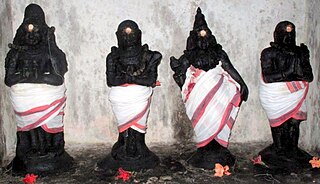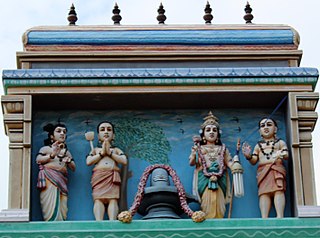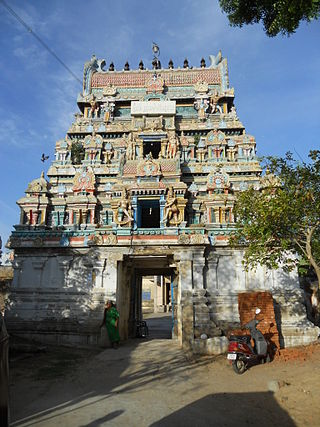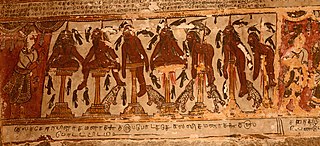Related Research Articles

Sambandar, also referred to as Tirujnana Sambandar, was a Shaiva poet-saint of Tamil Nadu who lived sometime in the 7th century CE. According to the Tamil Shaiva tradition, he composed an oeuvre of 16,000 hymns in complex meters, of which 383 (384) hymns with 4,181 stanzas have survived. These narrate an intense loving devotion (bhakti) to the Hindu god Shiva. Sambandar died when he was sixteen years of age. The surviving compositions of the poet-saint are preserved in the first three volumes of the Tirumurai, and provide a part of the philosophical foundation of Shaiva Siddhanta.

Tirumurai is a twelve-volume compendium of songs or hymns in praise of Shiva in the Tamil language from the 6th to the 11th century CE by various poets in Tamil Nadu. Nambiyandar Nambi compiled the first seven volumes by Appar, Sambandar, and Sundarar as Tevaram during the 12th century. During the course of time, a strong necessity was felt by scholars to compile Shaiva literature to accommodate other works. Tiruvasakam and Tirukovayar by Manickavasagar are included as the eighth, nine parts are compiled as the ninth Tirumurai out of which most are unknown, and the tenth as Tirumandiram by Tirumular, the famous Siddhar. The eleventh is compiled by Karaikal Ammaiyar, Cheraman Perumal and others. The contemporary Chola king was impressed by the work of Nambi and included Nambi's work in the eleventh Tirumurai. Sekkilar's Periya Puranam, composed a century later, contains the life depiction of all the 63 Nayanmars. The response for the work was so tremendous among Shaiva scholars and Kulothunga Chola II that it was included as the 12th Tirumurai. Tirumurai along with Vedas and Shaiva agamas form the basis of Shaiva Siddantha philosophy in South India and Sri Lanka.

The Nayanars were a group of 63 Tamil Hindu saints living during the 6th to 8th centuries CE who were devoted to the Hindu god Shiva. Along with the Alvars, their contemporaries who were devoted to Vishnu, they influenced the Bhakti movement in early medieval South India. The names of the Nayanars were first compiled by Sundarar. The list was expanded by Nambiyandar Nambi during his compilation of material by the poets for the Tirumurai collection, and would include Sundarar himself and Sundarar's parents.

Thiruvasagam is a volume of Tamil hymns composed by the ninth century Shaivite bhakti poet Manikkavasagar. It contains 51 compositions and constitutes the eighth volume of the Tirumurai, the sacred anthology of the Tamil Shaiva Siddhanta.

The Periya purāṇam, that is, the great purana or epic, sometimes called Tiruttontarpuranam, is a Tamil poetic account depicting the lives of the sixty-three Nayanars, the canonical poets of Tamil Shaivism. It was compiled during the 12th century by Sekkilar. The Periya Puranam is part of the corpus of Shaiva canonical works.

Appar also referred to as Tirunavukkaracar or Navukkarasar, was a seventh-century Tamil Shaiva poet-saint. Born in a peasant Shaiva family, raised as an orphan by his sister, he lived about 80 years and is generally placed sometime between 570 and 650 CE. Appar composed 4,900 devotional hymns to the god Shiva, out of which 313 have survived and are now canonized as the 4th to 6th volumes of Tirumurai. One of the most prominent of the sixty-three revered Nayanars, he was an older contemporary of Sambandar.

Sundarar, also referred to as Chuntarar, Chuntaramurtti, Nampi Aruran or Tampiran Tolan, was an eighth-century poet-saint of Tamil Shaiva Siddhanta tradition of Hinduism. He is among the Tevaram trio, and one of the most prominent Nayanars, the Shaiva bhakti (devotional) poets of Tamil Nadu.

The Tevaram, also spelled Thevaram, denotes the first seven volumes of the twelve-volume collection Tirumurai, a Shaiva narrative of epic and Puranic heroes, as well as a hagiographic account of early Shaiva saints set in devotional poetry. The Tevaram volumes contain the works of the three most prominent Shaiva Tamil poets of the 7th and 8th centuries: Sambandar, Appar, and Sundarar. The three poets were not only involved in portraying their personal devotion to Shiva, but also engaged a community of believers through their songs. Their work is an important source for understanding the Shaiva Bhakti movement in the early medieval South India.
Arikesari Maravarman, also known as Parankusa, was a Pandya king of early medieval south India.

Edaganathar Temple is a Hindu temple dedicated to the deity Shiva, located in Thiruvedagam, a village in Madurai district in the South Indian state of Tamil Nadu. The temple is located on the banks of Vaigai River. Shiva is worshipped as Edaganathar, and is represented by the lingam. His consort Parvati is depicted as Visalakshi. The presiding deity is revered in the 7th century Tamil Saiva canonical work, the Tevaram, written by Tamil saint poets known as the nayanars and classified as Paadal Petra Sthalam.
Koon Pandiyan was the nickname of a king who ruled Madurai around 7th century. Some historians identify him with the Pandyan king Arikesari Parankusa Maravarman.

Jainism has an extensive history in the Indian state of Tamil Nadu, although practiced by a minority of Tamils in contemporary times. According to the 2011 India Census, Jains represent 0.12% of the total population of Tamil Nadu, and are of the Digambara sect. Tamil Jains are primarily concentrated in northern Tamil Nadu, in the districts of Madurai, Viluppuram, Kanchipuram, Vellore, Tiruvannamalai, Cuddalore and Thanjavur.

Padikasu Nathar Temple is a Hindu temple located at Azhagaputhur, a village in the Thanjavur district of Tamil Nadu, India. Shiva is worshiped as Padikasunathar, and is represented by the lingam. His consort Parvati is depicted as Soundaranayagi. The presiding deity is revered in the 7th century Tamil Saiva canonical work, the Tevaram, written by Tamil saint poets known as the nayanars and classified as Paadal Petra Sthalam. The 8th century Saiva saint poet Sundarar has sung praise about the temple in his works.

The impalement of the Jains is a South Indian legend, first mentioned in an 11th-century hagiographic Tamil language text of Nambiyandar Nambi. According to the legend, Sambandar, who lived in the 7th century CE, defeated the Tamil Jain monks in a series of debates and contests on philosophy, thereby converted a Jain Pandyan king to Shaivism. The episode ended with the (voluntary) impalement of 8,000 Tamil Jains or Samanars as they were called.
Samanatham is the name of a panchayat village in the Madurai district of Tamil Nadu, India. It comes under the Thiruparankundram block."Sama Natham" a corrupt version of 'Samanar Rattham' or 'blood of Jains' is situated about six kilometers away from Madurai and a winding path among Acacia bushes and thorns leads one to a place worshipped as Mayandi temple. The place is isolated and is located in an eerie environment. But for the 10 foot trident and stone pillars with a hanging bell, there is nothing to suggest that it is a temple.
Mangayarkkarasiyar (Tamil:மங்கையர்க்கரசியார்) was one of the 63 Nayanmars or holy Saivite saints who are revered in South India. She is one among the only three women who attained this distinction. Her devotion to Lord Shiva is recounted in the hagiographic poem Periyapuranam compiled by Sekkizhar as well as in the Tiruthondar Thogai written by the poet-saint Sundarar.

Sakkiya Nayanar was a Nayanar saint, venerated in the Shaiva sect of Hinduism. He is generally counted as the thirty-fourth in the list of 63 Nayanars. He was a Buddhist, who converted to Shaivism.
Kungiliya Kalaya Nayanar, also known as Kungiliya Kalaya, Kalayar, Kunguliya and Kalaya Nayanar, is a Nayanar saint, venerated in the Hindu sect of Shaivism. He is generally counted as the eleventh in the list of 63 Nayanars.
Murthi Nayanar, also spelt as Murthy Nayanar, Moorthy Nayanar and Murti Nayanar and also known as Murtti, is a Nayanar saint, venerated in the Hindu sect of Shaivism. He is generally counted as the fifteenth in the list of 63 Nayanars.
Tiru Nilakanta Yazhpanar was a Nayanar saint, venerated in the Hindu sect of Shaivism. He is generally counted as the sixty-first in the list of 63 Nayanars. While the first part of his name can be spelt as Tirunilakanta, Tirunilakantha, Tiru Neelakanta, Tiru Nilakanta, Nilakantan and Thiruneelakanda, Yazhpanar is spelt as variously as Yalppanar, Yalapannar, Yalpanar and Yazhpaanar. He is described as a companion of Sambandar, one of the most prominent Nayanars.
References
- ↑ "Staunch devotion". The Hindu.
- ↑ "குலச்சிறை நாயனார் - 63 நாயன்மார்கள்". Dina Malar. Retrieved 20 February 2014.
- ↑ Nair, Kunhi Krishnan (2007). Sages Through Ages : India's Heritage. Bloomington, IN : AuthorHouse, ©2007. p. 67. ISBN 9781434334480.
- ↑ "Staunch devotion". The Hindu. Retrieved 20 February 2014.

